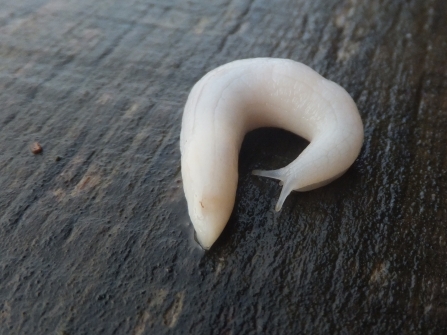
This ghost slug was discovered in DWT's Cricklepit Mill garden. Photo: Phil Sansum
The riddle may sound like the plot of a supernatural Christmas tale. And indeed, conservationists in Devon do believe that they have discovered a ghost. But it just so happens that this ghost is not a Yuletide apparition, but a slug.
The mollusc in question is called a Ghost Slug, a species which is normally a native of the Ukraine where it lives in mountain forests. But this Ghost Slug has turned up in the gardens of Devon Wildlife Trust’s Cricklepit Mill, in the middle of urban Exeter.
It’s thought to be the first time the slug, which has the scientific name Selenochlamys ysbryda, has been found in Devon. The species was first reported in the UK in 2008. Since then there have been a scattering of ghost slug sightings, mainly from South Wales, in and around Cardiff.
The slug which can measure up to 7 or 8cm in length, is a distinctive, ghostly white in colour. Even its eye stalks and eyes are white, indeed Ghosts Slugs are thought to be blind. It’s these unusual looks which have given rise to the name, Ghost Slug.
Devon Wildlife Trust’s Steve Hussey said:
“We’re not sure how the Ghost Slug found its way into our garden. It may have been introduced on plants, soil or compost brought in from elsewhere.
We were lucky that an experienced ecologist was on hand to make the identification. This species may be present in other Devon locations but because it isn’t easy to spot and because little is known about it, it may be that they are under-recorded elsewhere.”
Ghost Slugs are elusive. This is in part because they are most active at night, but also because they spend much of their lives under the surface of the soil. In fact, the slugs are capable of burrowing to depths of a metre. They do this in the pursuit of earth worms which they catch and devour using their specially adapted mouths which contain rows of tiny, rasp-like teeth.
These predatory instincts are causing some concern to ecologists. The presence of ghost slugs means that the UK’s native earthworms could be facing a predator which they have never encountered before and one to which they have no natural defence.
People suspected of seeing a Ghost Slug should take a photo of the slug and send it along with the exact location of the find (including a postcode or map grid reference to) and time/date to Devon Biodiversity Records Centre via their website.
